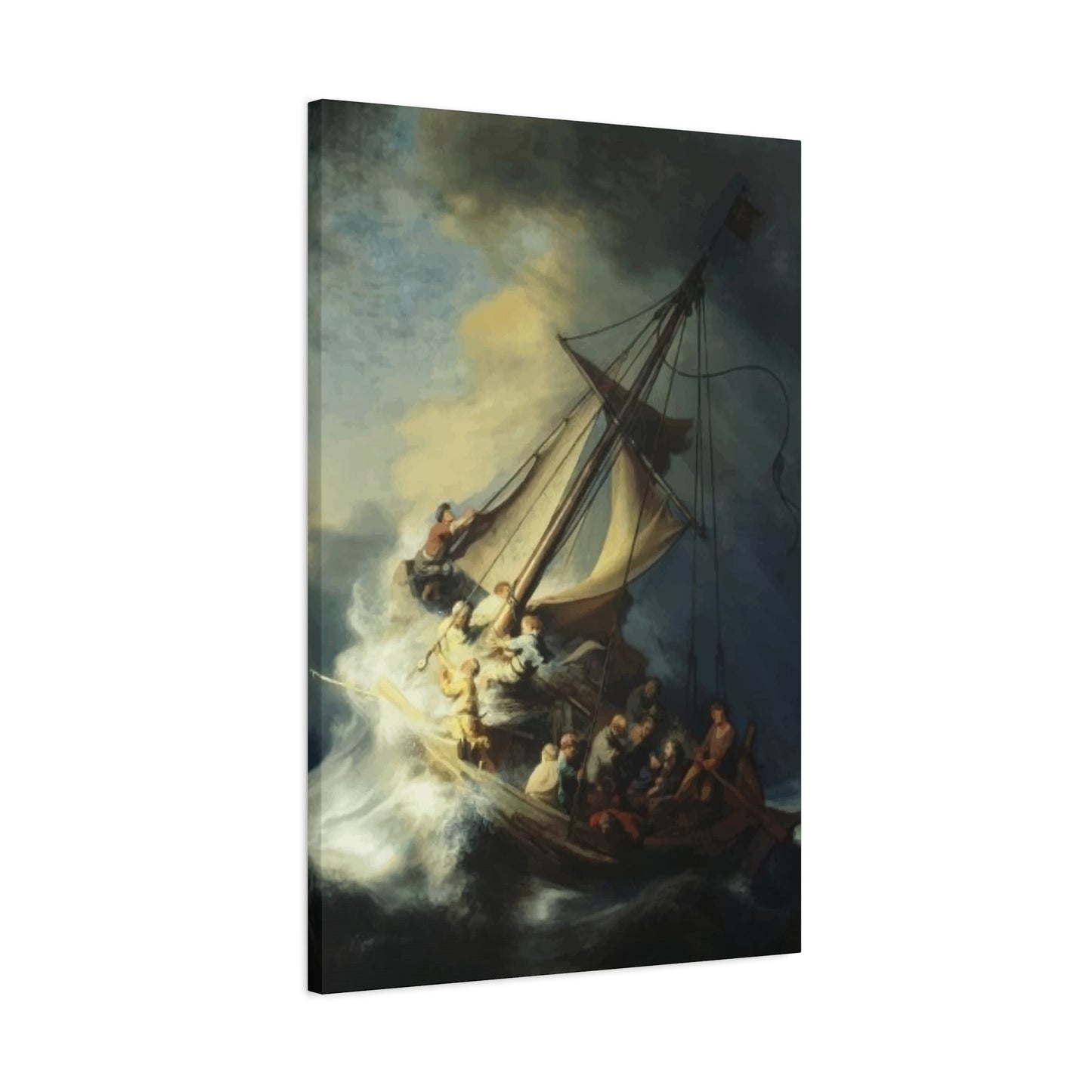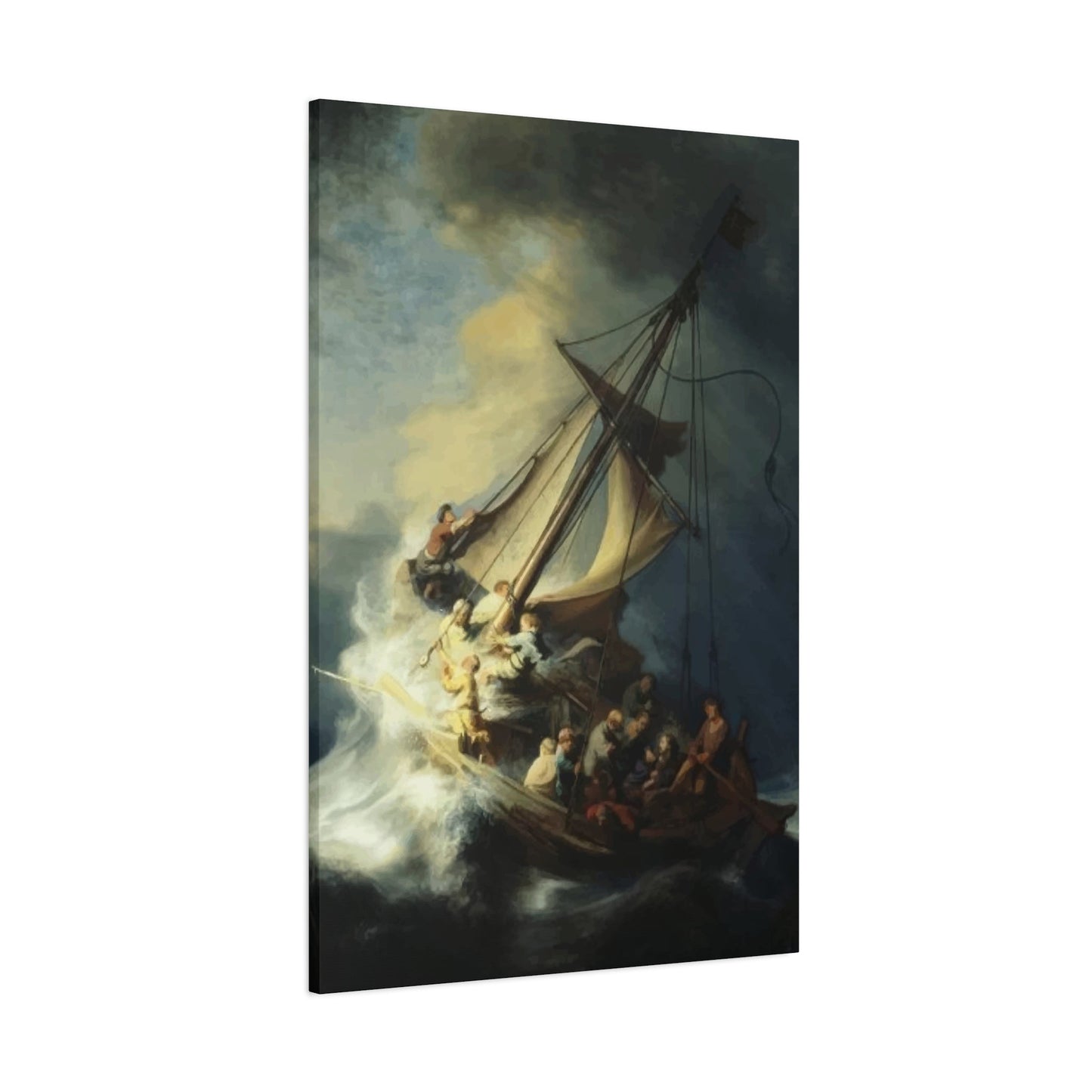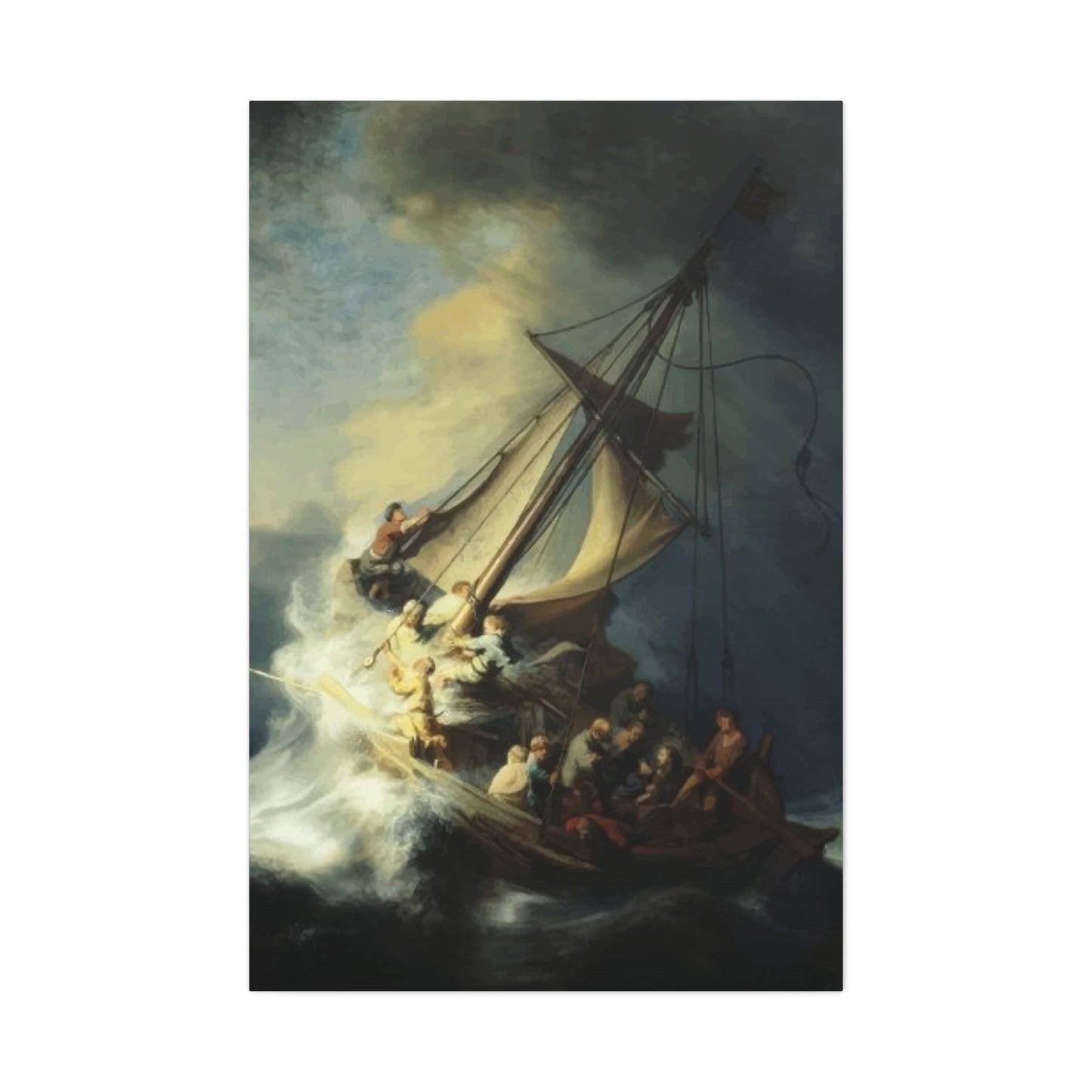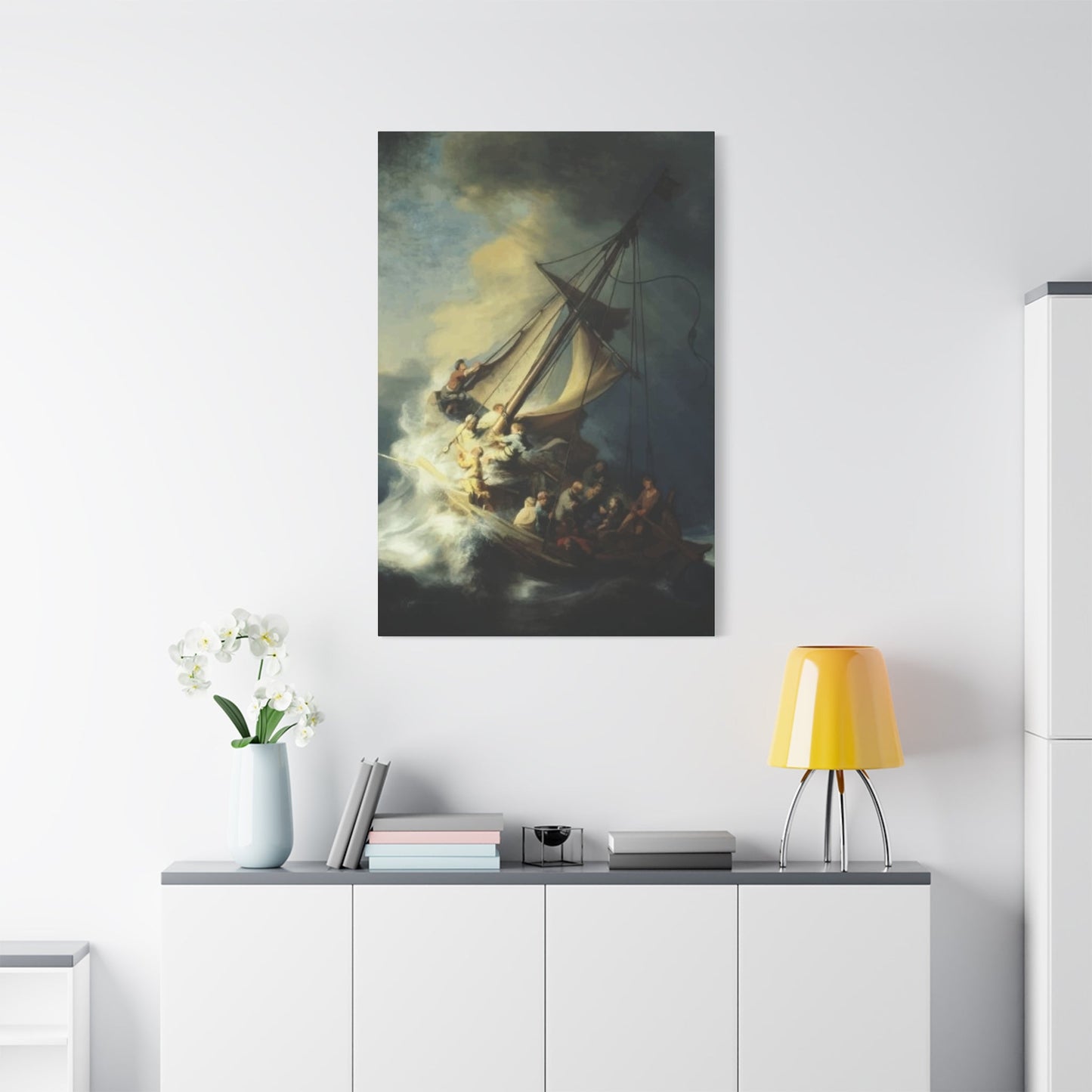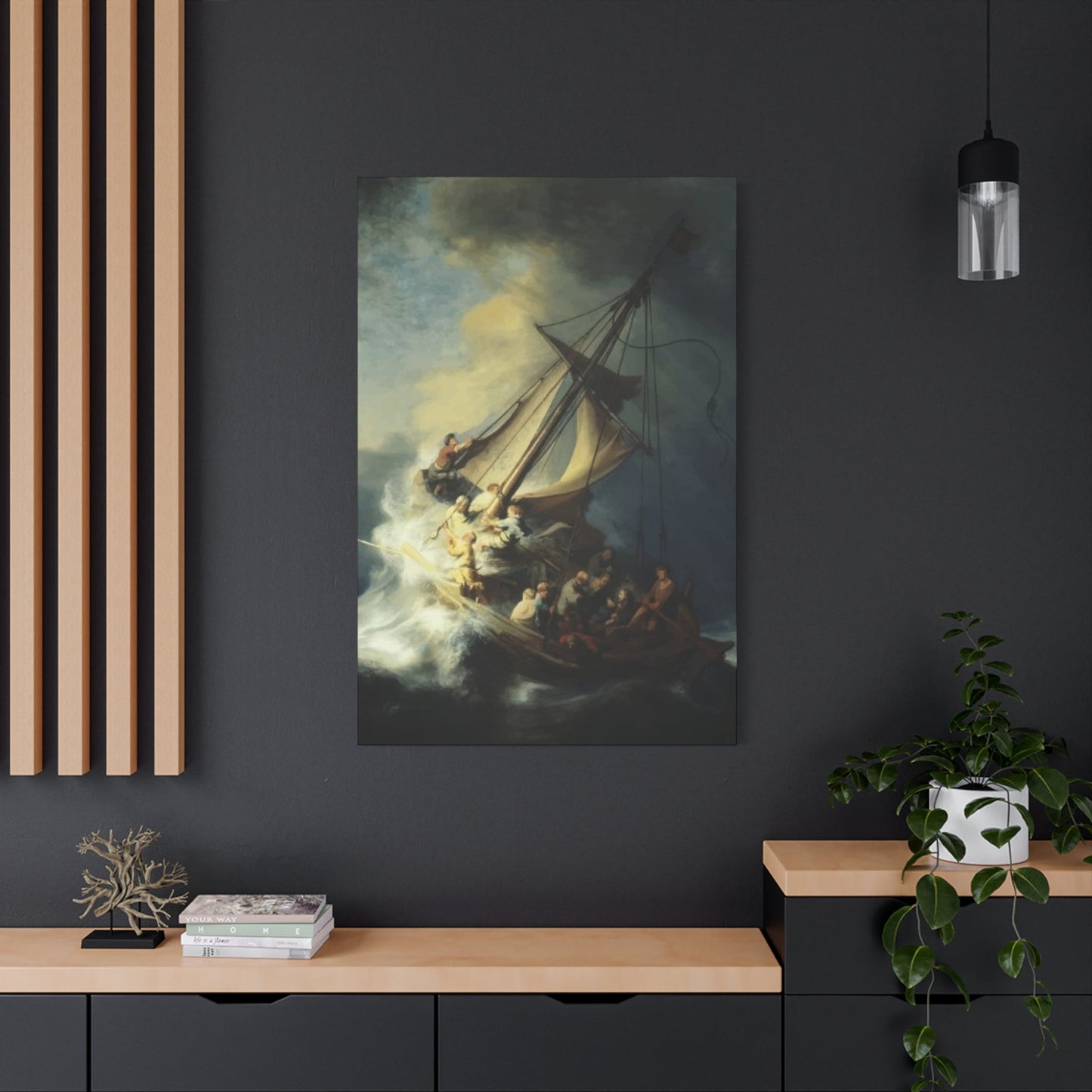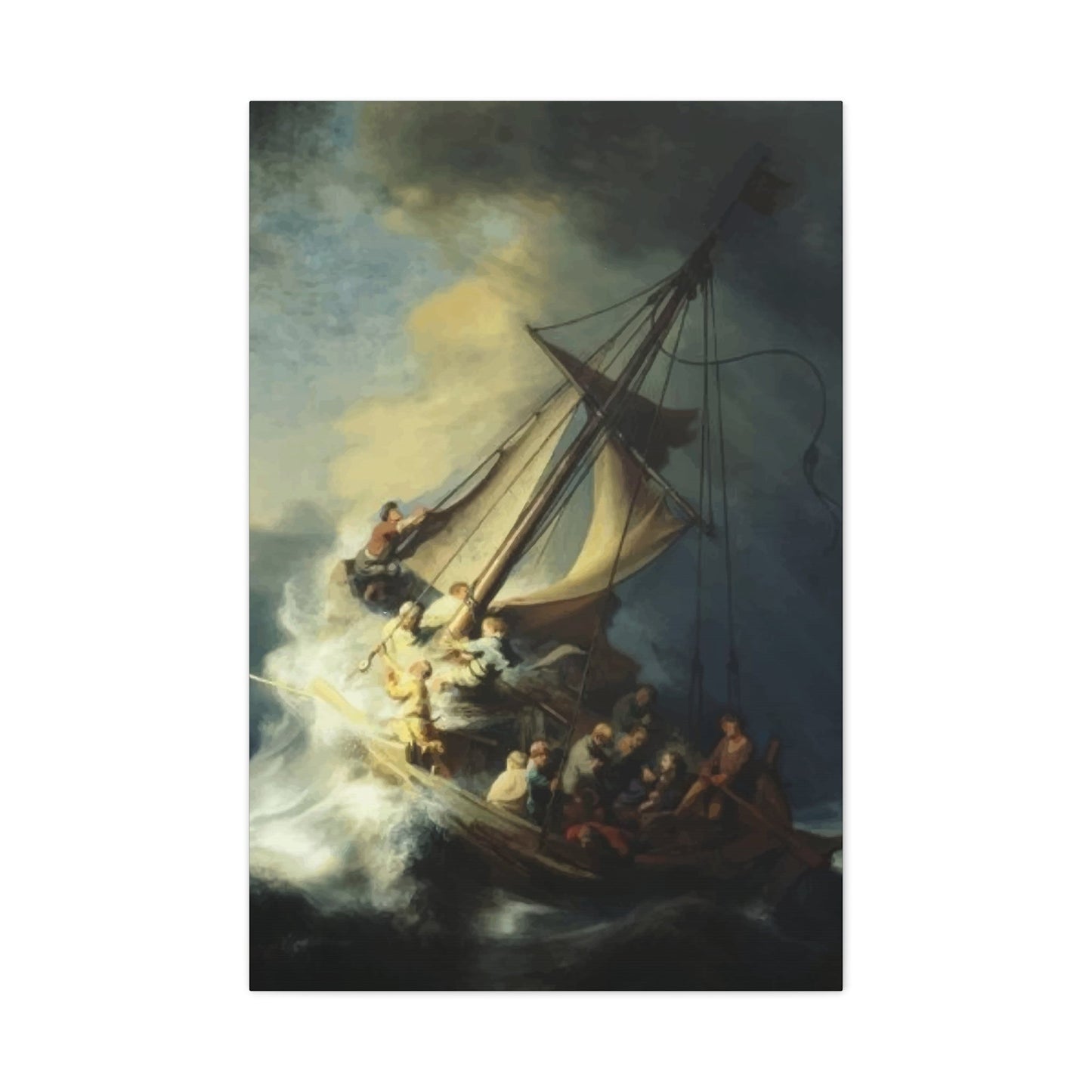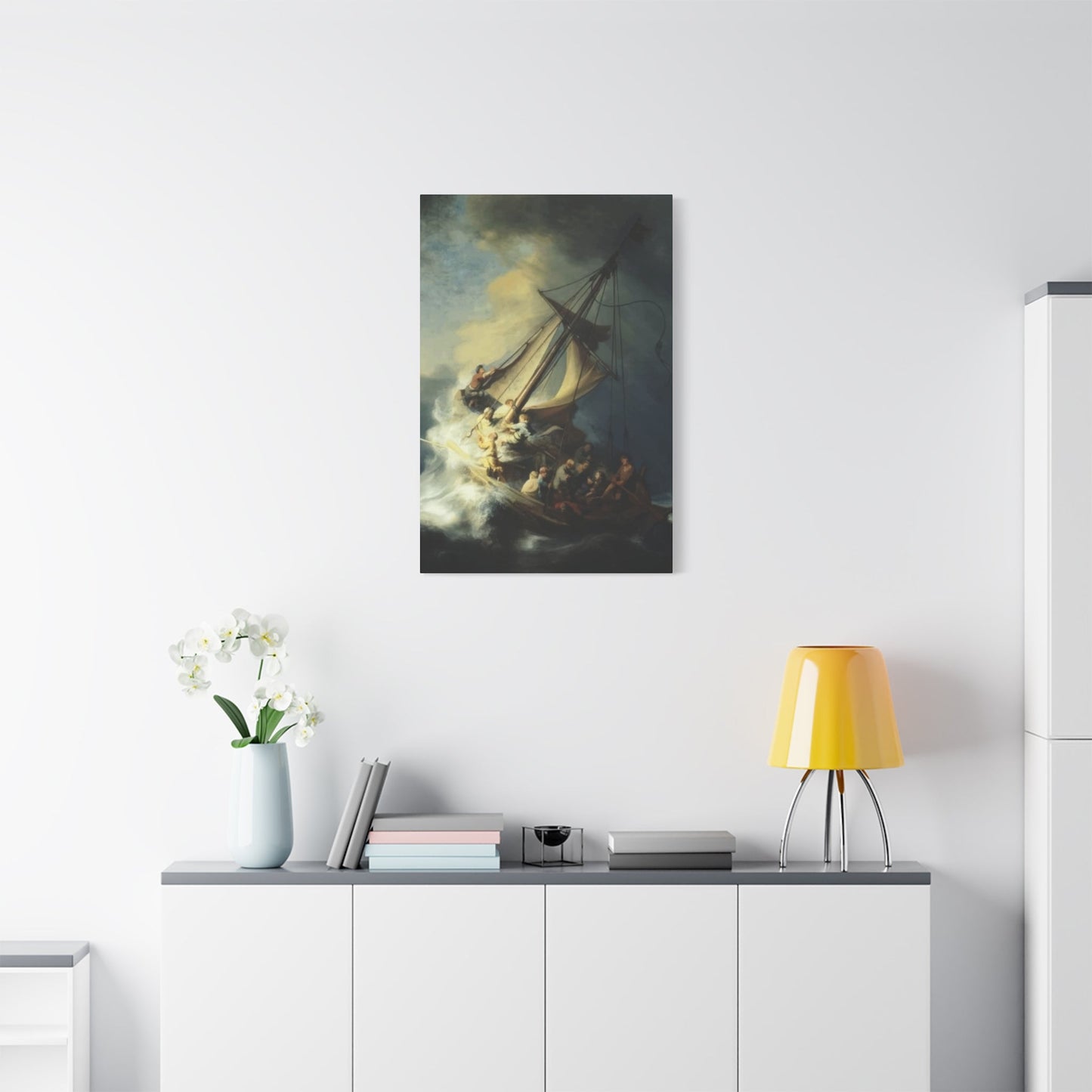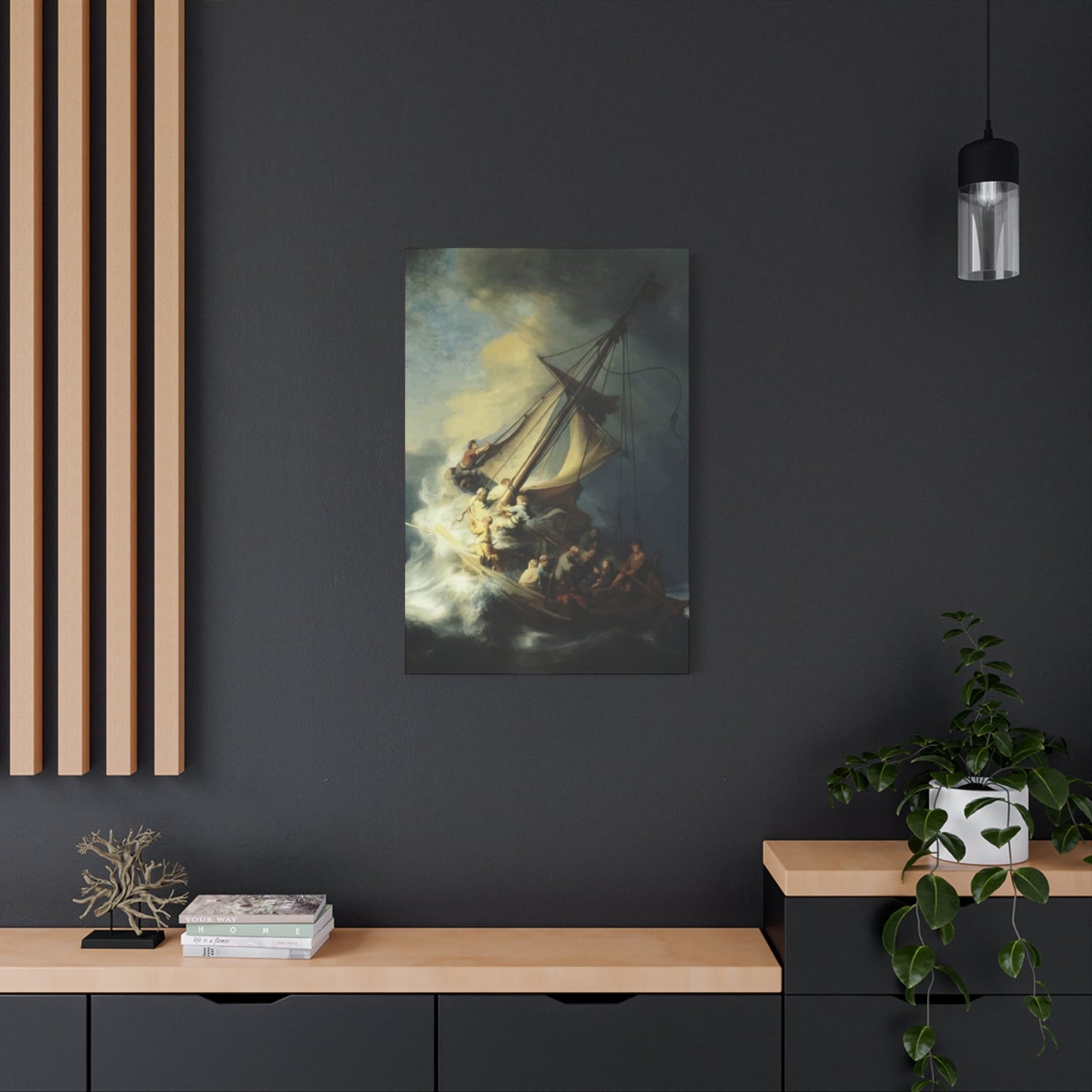Creating Dynamic Focal Points with Boat in Storm Wall Art
The artistic representation of vessels navigating turbulent waters has captivated audiences for centuries, serving as a profound metaphor for human perseverance and the eternal struggle against nature's overwhelming forces. Maritime storm art encompasses a rich tradition that combines technical mastery with emotional depth, creating visual narratives that resonate with viewers on multiple levels. These powerful artworks transcend mere decoration, offering windows into the human experience of confronting adversity with courage and determination.
The allure of stormy maritime scenes lies in their ability to capture the raw essence of nature's power while simultaneously celebrating human resilience. When artists depict boats battling against fierce winds and towering waves, they create more than just dramatic imagery; they craft symbols of hope, endurance, and the indomitable spirit that drives humanity forward even in the face of seemingly insurmountable challenges. This artistic genre has evolved significantly throughout history, adapting to changing aesthetic preferences while maintaining its core emotional impact.
Contemporary collectors and art enthusiasts are increasingly drawn to these dynamic compositions, recognizing their ability to transform living spaces and create compelling focal points. The modern interpretation of stormy boat art continues to honor traditional techniques while embracing innovative approaches that speak to today's audiences. From intimate residential settings to grand corporate environments, these artworks serve as powerful conversation starters and sources of inspiration.
Maritime Tempests as Metaphors for Human Endurance
The profound connection between stormy seas and human resilience emerges from our collective understanding of life's inevitable challenges. Artists who specialize in maritime storm scenes tap into universal experiences of struggle, perseverance, and triumph over adversity. The boat becomes a vessel for human dreams and aspirations, while the storm represents the obstacles we encounter on our journey through life. This symbolic relationship creates an immediate emotional connection between the artwork and the viewer, making these pieces particularly meaningful in personal and professional spaces.
The psychological impact of viewing stormy maritime art can be surprisingly uplifting. Rather than conveying despair or hopelessness, well-executed storm scenes often inspire viewers with their depiction of determination and courage. The boat's captain and crew, though often unseen in the artwork, are implied heroes who refuse to surrender to the tempest's fury. This narrative of resilience resonates particularly strongly in contemporary society, where individuals face various forms of personal and professional storms.
Artists achieve this emotional resonance through careful manipulation of visual elements. The contrast between the fragile-appearing vessel and the overwhelming power of the sea creates dramatic tension, while the boat's continued forward progress suggests hope and determination. The use of color, light, and composition work together to convey not just the physical reality of the storm, but the emotional journey of those who dare to challenge nature's might.
The historical context of maritime art adds another layer of meaning to these representations. Throughout human history, the sea has been both a source of sustenance and a formidable adversary. Coastal communities have long understood the dual nature of the ocean, respecting its power while depending on its resources. This cultural memory infuses stormy boat art with deeper significance, connecting viewers to generations of seafarers who faced similar challenges.
Modern interpretations of this theme often incorporate contemporary concerns and perspectives. Artists may use stormy maritime scenes to comment on environmental issues, economic uncertainty, or social upheaval. The boat becomes a symbol not just of individual resilience, but of collective human determination to navigate through difficult times. This evolution of meaning ensures that stormy boat art remains relevant and compelling to modern audiences.
The therapeutic value of these artworks should not be underestimated. Many viewers find comfort and strength in contemplating scenes of boats successfully navigating through storms. The visual metaphor provides a framework for understanding personal challenges and finding hope in difficult circumstances. This psychological benefit makes stormy maritime art particularly valuable in healthcare settings, counseling offices, and other environments where people seek comfort and inspiration.
Interior Design Strategies for Nautical Storm Canvas Art
Incorporating stormy boat canvas prints into interior design requires thoughtful consideration of space, lighting, and overall aesthetic goals. These dramatic artworks possess the power to transform any room, but their impact depends heavily on proper placement and integration with existing design elements. The key to successful integration lies in understanding how these pieces interact with their surroundings and complement the room's intended atmosphere.
When selecting locations for stormy maritime art, consider the room's primary function and the emotional tone you wish to establish. Living rooms benefit from these pieces as they create natural conversation focal points and establish a sense of drama and sophistication. The dynamic energy of stormy seas can enliven social spaces while providing visual interest that draws guests deeper into the room. Bedrooms, while less conventional choices, can also accommodate these artworks when balanced with calming elements that prevent the space from becoming too stimulating.
Color coordination plays a crucial role in successfully integrating stormy boat art into your design scheme. The typically dramatic color palette of these pieces – featuring deep blues, stormy grays, and white-capped waves – can serve as the foundation for an entire room's color story. Consider pulling accent colors from the artwork to use in textiles, accessories, and other decorative elements. This approach creates visual cohesion while allowing the artwork to maintain its prominence as a design anchor.
The scale of stormy maritime art should be carefully matched to the dimensions of the intended space. Large-scale pieces work best in rooms with high ceilings and ample wall space, where they can achieve maximum visual impact without overwhelming the environment. Smaller prints can be effective in intimate spaces or as part of gallery walls that tell a broader nautical story. The key is ensuring that the artwork's size allows viewers to appreciate both its overall composition and intricate details.
Lighting considerations become particularly important when displaying stormy boat art, as proper illumination can dramatically enhance the artwork's emotional impact. Natural light can bring out subtle color variations and create dynamic shadows that change throughout the day, adding an element of movement that complements the artwork's stormy theme. Artificial lighting should be positioned to minimize glare while providing even illumination that allows viewers to appreciate the artwork's full range of tones and textures.
The architectural context of the room influences how stormy maritime art should be integrated into the overall design. Traditional spaces with classic architectural details can accommodate more classical interpretations of stormy boat scenes, while contemporary environments may call for modern artistic approaches to the theme. The key is ensuring that the artwork's style complements rather than conflicts with the room's architectural character.
Furniture placement and room layout should be considered in relation to the artwork's positioning. Seating arrangements that allow comfortable viewing of the artwork enhance its impact and encourage contemplation. Consider creating clear sight lines from key seating areas to ensure that the artwork can be properly appreciated from multiple vantage points throughout the room.
Dramatic Tension in Maritime Storm Compositions
The artistic power of boats battling rough waters lies in the masterful creation of visual tension that keeps viewers emotionally engaged. This tension emerges from the careful balance between opposing forces – the fragile human-made vessel against nature's overwhelming power, movement against stability, hope against despair. Artists who excel in this genre understand how to manipulate these contrasts to create compositions that are both visually compelling and emotionally resonant.
The composition techniques used in stormy maritime art often employ diagonal lines and dynamic angles to convey movement and instability. The boat may be positioned at a dramatic angle, suggesting its struggle against powerful waves, while the waves themselves create sweeping curves that lead the eye through the composition. This careful orchestration of visual elements creates a sense of movement that makes static artworks feel alive with energy and motion.
Color relationships in stormy boat scenes contribute significantly to the overall dramatic impact. The contrast between the dark, threatening sky and the white foam of crashing waves creates visual excitement, while the boat itself may be rendered in colors that either blend with or stand out from its turbulent environment. Artists make deliberate choices about whether to make the vessel a beacon of hope through warm colors or emphasize its vulnerability through cooler, more muted tones.
The scale relationships within these compositions often play with viewer expectations to heighten dramatic impact. A small boat dwarfed by massive waves emphasizes human vulnerability and the magnitude of natural forces. Conversely, a larger vessel that fills more of the composition frame can suggest human determination and capability in the face of adversity. These decisions about relative scale directly influence how viewers interpret the artwork's message about human resilience.
Atmospheric effects in stormy maritime art contribute to the overall sense of drama and realism. Artists may use techniques such as spray, mist, and rain to create layers of visual depth that make viewers feel immersed in the storm's fury. These atmospheric elements also serve to blur the boundaries between sea and sky, creating a sense of total envelopment that intensifies the dramatic situation.
The temporal aspect of these compositions – the sense of captured motion and implied before-and-after narratives – adds another dimension to their dramatic power. Viewers naturally wonder about the boat's journey, imagining both its origins and its destination. This narrative quality transforms static artworks into dynamic stories that continue to unfold in the viewer's imagination long after the initial viewing.
The psychological impact of these dramatic compositions extends beyond mere visual appreciation. The tension created by the artwork can serve as a metaphor for personal struggles, making these pieces particularly meaningful to viewers facing their own life challenges. The boat's determined progress through the storm becomes a source of inspiration and hope, demonstrating that persistence and courage can overcome even the most daunting obstacles.
Selecting Appropriate Dimensions for Maritime Storm Prints
The process of choosing the right size for boat storm prints involves careful consideration of multiple factors that influence both aesthetic impact and practical integration within living spaces. The dimensions of nautical storm artwork directly affect its ability to command attention, convey emotional power, and harmonize with surrounding design elements. Understanding these relationships enables collectors to make informed decisions that maximize their artwork's impact while ensuring successful integration into their intended environments.
Room proportions serve as the foundation for size selection decisions. Large rooms with high ceilings can accommodate impressive large-scale pieces that might overwhelm smaller spaces. The general rule suggests that artwork should occupy roughly two-thirds to three-quarters of available wall space to achieve optimal visual balance. However, stormy maritime art often benefits from slightly larger proportions due to its dramatic subject matter, which requires adequate space to convey the full scope of nature's power and the boat's courageous journey through turbulent waters.
Viewing distance plays a crucial role in determining appropriate artwork dimensions. Pieces intended for close viewing, such as those placed in intimate seating areas or hallways, can feature intricate details that reward careful examination. Larger prints allow viewers to appreciate both the overall composition and subtle artistic techniques from various distances. The layered nature of stormy boat scenes, with their complex interplay of water, sky, and vessel elements, particularly benefits from larger formats that provide space for visual exploration.
The artwork's intended function within the room influences optimal size selection. Statement pieces designed to serve as primary focal points require dimensions that command attention without overwhelming other design elements. Complementary pieces that support broader decorative themes can be smaller while still contributing meaningfully to the overall aesthetic narrative. Consider how the stormy boat print will interact with furniture arrangements, architectural features, and other artworks to determine the most effective size for your specific application.
Multiple print arrangements offer alternatives to single large-scale pieces while still achieving significant visual impact. Series of related stormy maritime images can create compelling gallery walls that tell broader narrational stories about seafaring adventures and human resilience. These arrangements allow for flexible sizing options while maintaining thematic coherence that reinforces the emotional power of stormy boat imagery.
The technical quality and resolution of canvas prints influence how well they perform at different sizes. High-quality prints can be enlarged significantly without losing detail or suffering degradation in color quality. This flexibility allows collectors to prioritize room requirements and aesthetic preferences while maintaining artwork integrity. However, understanding the source image's limitations helps prevent disappointing results from excessive enlargement.
Budget considerations often influence size selection, as larger prints typically command higher prices. However, the long-term satisfaction derived from properly sized artwork that successfully integrates into its intended space often justifies the additional investment. Consider the cost-per-impact ratio rather than simply focusing on initial price, as a well-chosen piece can provide years of visual enjoyment and emotional inspiration.
Symbolic Meanings in Turbulent Weather Marine Art
The rich symbolism embedded within stormy weather maritime art creates layers of meaning that extend far beyond surface-level visual appreciation. These artworks function as complex metaphorical systems where every element – from the boat's position to the storm's intensity – contributes to deeper narratives about human experience, spiritual journey, and the eternal struggle between order and chaos. Understanding these symbolic dimensions enhances both the selection and appreciation of stormy maritime art.
The boat itself serves as perhaps the most powerful symbol in these compositions, representing human consciousness, determination, and the vessel that carries us through life's challenges. Different types of vessels convey varying symbolic meanings: sailing ships suggest reliance on natural forces and harmony with the environment, while motorized boats might represent human technological prowess and determination to overcome natural obstacles through innovation and power. The boat's condition, size, and apparent seaworthiness all contribute to the artwork's symbolic message about human capability and resilience.
Storms in maritime art symbolize the inevitable challenges and transitions that characterize human existence. The intensity of the depicted weather corresponds to the magnitude of life's difficulties, while the storm's stage – building, raging, or subsiding – suggests different phases of personal or collective struggles. Lightning may represent sudden insights or dramatic revelations, while persistent rain can symbolize ongoing difficulties that test endurance and patience. The storm's portrayal directly influences how viewers interpret the artwork's message about confronting adversity.
Water itself carries profound symbolic weight in these compositions, representing the unconscious mind, emotional depths, and the primordial source of life. Calm water might suggest peace and stability, while turbulent seas indicate emotional turmoil or psychological upheaval. The way waves are depicted – their size, direction, and relationship to the boat – creates symbolic statements about the nature of challenges faced and the protagonist's response to them. Crashing waves might represent overwhelming emotions, while rolling swells could suggest manageable but persistent difficulties.
The sky's appearance in stormy maritime art provides additional symbolic layers related to hope, divine intervention, and future possibilities. Dark, threatening clouds might represent despair or unknown dangers, while breaks in the cloud cover suggest hope and the possibility of better conditions ahead. The presence or absence of stars, moon, or sun adds spiritual dimensions that speak to faith, guidance, and the cyclical nature of difficulties and resolutions.
Color symbolism plays a crucial role in conveying emotional and spiritual meanings within these artworks. Deep blues often represent depth, mystery, and spiritual seeking, while grays might suggest uncertainty or neutral states between hope and despair. White-capped waves can symbolize purity, truth, or divine presence breaking through chaos, while darker water tones might represent hidden depths of experience or unconscious fears that must be navigated.
The composition's directional elements carry symbolic weight regarding life's journey and personal growth. Boats moving from left to right typically suggest progress and forward movement through time, while other directional choices might indicate different aspects of spiritual or psychological development. The boat's relationship to the picture frame – whether it appears to be entering, exiting, or centered within the composition – influences interpretations of the journey's stage and the individual's relationship to their current challenges.
Creating Bold Visual Statements with Storm-Tossed Vessel Art
The strategic use of stormy boat art as a bold statement piece requires understanding how these dramatic works interact with their surroundings to create powerful visual impact. These artworks possess inherent commanding presence due to their dynamic subject matter and emotional intensity, but maximizing their statement-making potential involves thoughtful consideration of placement, context, and supporting design elements that amplify rather than compete with their dramatic power.
The concept of visual dominance becomes crucial when using stormy maritime art as a statement piece. These works should be positioned where they can command attention without fighting other strong visual elements for prominence. Ideally, they become the anchor around which other design elements organize, creating a hierarchical relationship that guides viewers' eyes naturally through the space while maintaining focus on the artwork's dramatic narrative.
Contrast principles work particularly well with stormy boat art, as these pieces often benefit from being surrounded by calmer, more subdued design elements that allow their drama to shine. Neutral backgrounds in terms of both color and pattern provide the perfect stage for these dynamic compositions, while bold surrounding elements might compete for attention and diminish the artwork's impact. The goal is creating a visual environment where the stormy maritime scene can tell its story without interference.
Scale relationships become especially important when using these works as statement pieces. The artwork should be large enough to justify its dominant position while avoiding overwhelming the space entirely. Consider not just the wall space available, but also the room's volume and the viewing distances from primary seating areas. A piece that appears too small for its prominent position fails to deliver the intended impact, while an oversized work might make the space feel cramped or unbalanced.
Lighting strategies can significantly enhance the statement-making power of stormy maritime art. Dramatic lighting that emphasizes the artwork's tonal contrasts and textural qualities adds to its commanding presence. Consider using accent lighting to create subtle shadows and highlights that change throughout the day, adding an element of visual movement that complements the artwork's dynamic subject matter. The interplay between light and shadow can make the stormy scene appear even more dramatic and engaging.
The psychological positioning of statement artwork affects how viewers experience and interpret its message. Placing stormy boat art at eye level when seated encourages contemplative engagement, while higher placement might emphasize the artwork's aspirational or inspirational qualities. The viewing angle influences how the boat's journey through the storm is perceived – whether viewers feel like observers of the struggle or participants in the voyage.
Supporting design elements should be chosen to reinforce rather than distract from the artwork's powerful message. Furniture selection, color schemes, and decorative accessories can all contribute to creating an environment that amplifies the stormy maritime theme without becoming overly literal or themed. The goal is sophisticated integration that enhances the artwork's impact while maintaining design authenticity and avoiding cliché.
Optimal Positioning Strategies for Maritime Storm Wall Art
The placement of boat storm wall art requires strategic thinking about how these dynamic pieces will interact with room architecture, lighting conditions, and daily living patterns. Successful positioning maximizes both visual impact and emotional connection while ensuring the artwork integrates harmoniously with the space's functional requirements. The dramatic nature of stormy maritime scenes makes them particularly sensitive to placement decisions that can either enhance or diminish their powerful effect on viewers.
Architectural considerations form the foundation of effective placement strategies. Wall size and shape influence how stormy boat art will appear within its architectural context. Large, uninterrupted walls provide ideal canvases for impressive maritime storm pieces, while smaller or irregularly shaped walls might require careful sizing and positioning to achieve optimal integration. Consider how architectural features such as windows, doorways, and built-in elements affect the artwork's visual relationship with its surroundings.
Traffic flow patterns within rooms influence how and when occupants encounter stormy maritime artwork. Positioning pieces where they can be appreciated from natural walking paths ensures regular engagement with their powerful imagery. However, avoid placing dramatic artworks where they might be distracting from essential activities or create visual conflicts with functional areas. The goal is creating opportunities for meaningful interaction without disrupting the room's practical utility.
Seating relationship considerations ensure that stormy boat art can be properly appreciated from key viewing positions. Primary seating areas should offer comfortable sight lines to featured artworks, allowing for both casual glances and focused contemplation. The viewing angle affects how the boat's struggle through stormy waters is perceived, with straight-on views typically providing the most powerful emotional impact. Consider multiple seating positions to ensure the artwork remains engaging from various vantage points.
Natural light interactions can dramatically affect how stormy maritime art appears throughout the day. Morning light might emphasize certain color aspects, while afternoon illumination could highlight different textural qualities. Consider how changing light conditions will affect the artwork's appearance and mood. Some pieces benefit from consistent artificial lighting to maintain their intended impact regardless of natural light variations, while others come alive with changing illumination that adds temporal interest to their dramatic scenes.
Room function influences appropriate placement strategies for different types of spaces. Living rooms and common areas can accommodate more dramatically positioned pieces that serve as conversation focal points, while bedrooms might require more subtle positioning that provides inspiration without overstimulation. Office spaces benefit from placement that offers periodic visual respite and inspiration without creating distraction from work activities.
Height considerations affect both visual impact and practical maintenance of stormy boat wall art. Eye level positioning when seated provides optimal viewing for detailed appreciation, while higher placement can create more dramatic architectural integration. Consider the room's ceiling height, furniture scale, and intended viewing positions when determining optimal hanging height. Remember that dramatic maritime scenes often benefit from positioning that allows viewers to look slightly upward, suggesting aspiration and hope.
Multiple piece arrangements require careful choreography to create cohesive visual narratives without overwhelming spaces. Series of related stormy boat images can tell expanded stories about maritime adventures and human resilience, but they require thoughtful spacing and sizing to maintain individual impact while contributing to collective meaning. Consider how multiple pieces will work together to create gallery wall arrangements that enhance rather than compete with each other.
Psychological and Emotional Responses to Nautical Storm Scenes
The emotional impact of stormy boat scenes extends far beyond mere visual appreciation, tapping into deep psychological responses that connect with fundamental human experiences of struggle, courage, and perseverance. These artworks trigger complex emotional reactions that can range from exhilaration and inspiration to contemplation and introspection, depending on the viewer's personal experiences and current life circumstances. Understanding these psychological dimensions helps explain why stormy maritime art maintains such enduring appeal across diverse audiences and cultural contexts.
The concept of vicarious resilience plays a significant role in how viewers respond to stormy boat imagery. Observing depictions of vessels successfully navigating through turbulent conditions can provide psychological encouragement to individuals facing their own challenges. This phenomenon operates through unconscious identification with the boat's crew and their determination to persevere despite overwhelming odds. The artwork becomes a visual metaphor that reinforces personal capabilities and hope for overcoming current difficulties.
Stress response patterns in viewers of stormy maritime art can be surprisingly positive, despite the dramatic subject matter. Rather than increasing anxiety, well-executed storm scenes often have a calming effect through their demonstration of successful navigation through chaos. The boat's continued progress through the storm suggests that challenges, no matter how severe, can be overcome through determination and skill. This message provides psychological comfort and stress relief for viewers dealing with their own turbulent circumstances.
The neurological impact of viewing dynamic maritime scenes involves the activation of mirror neurons that create empathetic responses to the depicted struggle. Viewers unconsciously experience some of the emotional journey portrayed in the artwork, from the tension of confronting the storm to the satisfaction of making progress despite obstacles. This neurological engagement creates lasting emotional connections that make stormy boat art particularly memorable and meaningful to those who experience it.
Memory associations triggered by stormy maritime imagery often connect to personal experiences of overcoming difficulties or witnessing others' courage in challenging situations. These artworks can evoke memories of personal resilience, family stories of perseverance, or cultural narratives about facing adversity with courage. The associative power of these images makes them particularly effective at reinforcing positive psychological patterns and encouraging optimistic thinking about future challenges.
Therapeutic applications of stormy boat art have been recognized in various healing contexts, from counseling offices to medical facilities. The visual metaphor of successfully navigating through storms provides a framework for discussing personal challenges and developing coping strategies. The artwork's presence creates a non-threatening way to explore difficult topics while maintaining focus on successful outcomes and the possibility of overcoming current obstacles.
The inspirational quality of these artworks operates through their ability to transform abstract concepts like perseverance and courage into concrete visual narratives. The boat becomes a tangible representation of human determination, while the storm represents specific challenges that viewers can relate to their own experiences. This transformation of abstract concepts into visual stories makes psychological growth and resilience feel more achievable and realistic.
Cultural resonance affects how different audiences respond to stormy maritime imagery, with coastal populations often showing stronger emotional connections due to personal familiarity with seafaring challenges. However, the metaphorical power of these scenes transcends literal maritime experience, speaking to universal human experiences of facing uncertainty and persevering through difficult periods. This broad appeal makes stormy boat art effective across diverse cultural and personal backgrounds.
Integrating Marine Themes with Storm-Swept Vessel Artwork
The successful integration of broader nautical themes with specific storm-swept vessel artwork creates cohesive design narratives that enhance both individual pieces and overall environmental storytelling. This approach allows collectors to build sophisticated maritime-inspired spaces that celebrate seafaring culture while maintaining focus on the dramatic power of boats battling rough waters. The key lies in balancing thematic consistency with visual variety to create engaging environments that avoid becoming overly literal or cliché.
Thematic layering techniques involve incorporating multiple levels of maritime reference that support and enhance storm-focused artwork without competing for attention. Base layers might include subtle nautical color palettes and textures that evoke oceanic environments, while secondary layers could incorporate maritime-inspired furniture pieces or architectural details. The storm-swept vessel art serves as the dramatic focal point around which these supporting elements organize, creating depth and richness without overwhelming the primary artistic statement.
Color harmony strategies help unite diverse maritime elements while maintaining the dramatic impact of stormy boat scenes. Ocean-inspired color palettes that emphasize blues, grays, and whites provide natural connections between different pieces and design elements. However, avoid overly literal color matching that might diminish the artwork's impact. Instead, consider how colors from the storm scene can be echoed and varied throughout the space in ways that create visual connections while allowing each element to maintain its individual character.
Texture combinations add tactile dimensions that reinforce maritime themes while complementing the visual drama of storm artwork. Rope details, weathered wood finishes, and metal accents can evoke seafaring environments without overwhelming stormy boat art. These textural elements should feel authentic rather than decorative, contributing to an overall sense of maritime authenticity that supports the artwork's narrative power. Consider how different textures interact with lighting to create visual interest that changes throughout the day.
Scale relationships between storm-focused artwork and supporting maritime elements require careful orchestration to maintain proper visual hierarchy. The stormy boat scene should remain the dominant element, with supporting pieces sized and positioned to enhance rather than compete with its dramatic impact. This might involve using smaller nautical accessories, incorporating maritime themes into functional elements like lighting fixtures, or selecting complementary artwork that operates at different scales to create visual rhythm without conflict.
Historical authenticity considerations help ensure that maritime theme integration feels genuine rather than superficial. Understanding traditional seafaring culture, ship design, and maritime art history provides foundation for making informed choices about supporting elements. This knowledge prevents common decorative mistakes that might undermine the sophisticated appeal of high-quality storm artwork. Authentic details add credibility and depth to the overall design narrative.
Seasonal adaptability allows maritime-themed spaces to remain fresh and engaging throughout the year. Storm-swept vessel art provides a dramatic constant around which seasonal maritime elements can rotate. Summer might emphasize lighter nautical touches, while winter could introduce elements that reinforce the artwork's themes of perseverance through challenging conditions. This flexibility maintains interest while honoring the timeless appeal of stormy maritime imagery.
Functional integration ensures that maritime theming enhances rather than complicates daily living. Storage solutions, seating arrangements, and lighting systems can incorporate nautical elements while serving practical needs. The goal is creating spaces that feel authentically maritime-inspired rather than decoratively themed, with storm artwork serving as the sophisticated centerpiece of a carefully curated environmental narrative.
Thoughtful Gift Selection Featuring Nautical Storm Art
The selection of boat storm wall art as gifts requires understanding both the recipient's personal taste and the deeper symbolic meanings these pieces convey. Stormy maritime artwork makes particularly meaningful gifts because it offers powerful messages of encouragement, resilience, and hope that can provide lasting inspiration to those facing life challenges or major transitions. The thoughtful selection process involves considering not just aesthetic preferences but also the emotional and psychological impact these dramatic pieces can have on their intended recipients.
Personality matching plays a crucial role in selecting appropriate stormy maritime gifts. Individuals who appreciate dramatic, emotionally powerful art often respond well to dynamic storm scenes that capture nature's raw power and human determination. Those facing significant life challenges might particularly value artwork that provides visual metaphors for perseverance and successful navigation through difficult periods. Consider the recipient's current life circumstances and how stormy boat imagery might provide encouragement or inspiration during challenging times.
Occasion appropriateness influences gift selection timing and presentation strategies. Graduation gifts featuring stormy maritime art symbolize the journey ahead and the recipient's capability to navigate future challenges. Career transition gifts emphasize professional resilience and determination, while wedding presents might celebrate the couple's commitment to weather life's storms together. Retirement gifts can honor a lifetime of perseverance while suggesting continued adventures ahead. Understanding these symbolic connections helps create more meaningful gift-giving experiences.
Size and placement considerations become particularly important when selecting artwork as gifts, since recipients will need to integrate pieces into their existing living spaces. Unless you're familiar with the recipient's home environment, consider selecting smaller to medium-sized pieces that offer more placement flexibility. Alternative presentation options, such as gift certificates that allow recipients to choose specific sizes and framing options, provide thoughtful solutions when space requirements are unknown.
Personal connection factors enhance the gift's meaning and long-term appreciation. Consider whether the recipient has maritime connections, personal experiences with boating or sailing, or cultural ties to coastal communities. However, remember that the metaphorical power of stormy boat art transcends literal nautical experience, making these pieces meaningful to anyone who appreciates powerful visual narratives about human resilience and determination. The universal appeal of these themes broadens potential recipient categories significantly.
Presentation strategies can significantly enhance the gift-giving experience and help recipients understand the artwork's deeper meanings. Consider accompanying the artwork with thoughtful notes explaining the symbolic significance of boats navigating through storms, or sharing personal reasons why you felt this particular piece would resonate with the recipient. This contextual information helps establish emotional connections that increase the artwork's long-term value and appreciation.
Budget considerations should account for not just the initial purchase price but also potential framing and presentation costs. High-quality stormy maritime prints deserve professional presentation that honors their dramatic subject matter and emotional significance. Consider whether the recipient would appreciate receiving the artwork ready to hang or would prefer to participate in framing decisions that reflect their personal style and home environment.
Cultural sensitivity awareness helps ensure that maritime storm imagery is appropriate for the intended recipient's cultural background and personal beliefs. While these themes generally resonate across diverse populations, understanding any cultural associations with stormy seas or maritime imagery helps avoid potential misunderstandings. The universal themes of perseverance and resilience typically translate well across cultural boundaries, making stormy boat art broadly appropriate for gift-giving situations.
Contemporary Approaches to Stormy Maritime Canvas Art
The evolution of stormy sea boat canvas prints reflects contemporary artistic movements while maintaining connection to traditional maritime art heritage. Modern artists approach these timeless themes with fresh perspectives that speak to current audiences while honoring the enduring appeal of boats battling rough waters. These contemporary interpretations often incorporate new techniques, materials, and conceptual frameworks that expand the genre's expressive possibilities while preserving its fundamental emotional power and symbolic resonance.
Digital art techniques have revolutionized how artists create and reproduce stormy maritime scenes, allowing for unprecedented detail and color accuracy in canvas prints. High-resolution digital processes enable artists to capture subtle atmospheric effects, complex water patterns, and intricate lighting conditions with remarkable precision. These technological advances make it possible to produce canvas prints that rival original paintings in visual impact while remaining accessible to broader audiences. The digital medium also allows for experimentation with color palettes and compositional elements that might be challenging to achieve through traditional painting methods.
Contemporary color theories influence how modern artists approach stormy maritime subjects, often resulting in more vibrant or unconventional color schemes that still maintain the dramatic impact essential to these compositions. Some artists experiment with heightened color saturation to create more emotionally intense experiences, while others explore monochromatic or limited palette approaches that emphasize form and movement over realistic color representation. These explorations demonstrate how traditional themes can be refreshed through innovative artistic approaches.
Abstract elements increasingly appear in contemporary stormy boat art, with artists incorporating non-representational forms that suggest movement, energy, and emotion without strictly adhering to realistic depiction. These abstract touches might appear in the treatment of water patterns, sky formations, or atmospheric effects, adding layers of interpretation that invite viewers to engage more actively with the artwork. The integration of abstract elements allows artists to emphasize the emotional and metaphorical aspects of their subjects while maintaining recognizable nautical themes.
Mixed media approaches combine traditional painting techniques with contemporary materials and methods, creating unique textures and visual effects that enhance the dramatic impact of stormy maritime scenes. Some artists incorporate actual nautical materials, weathered wood textures, or metallic elements that add dimensional qualities to canvas prints. These innovative approaches create artwork that engages multiple senses and provides rich visual experiences that reward close examination while maintaining strong impact from viewing distances.
Conceptual frameworks in contemporary stormy maritime art often address current social, environmental, or personal concerns through the metaphor of boats navigating challenging waters. Climate change, economic uncertainty, social upheaval, and personal transformation all find expression through updated interpretations of traditional storm-at-sea themes. These contemporary connections make the artwork more relevant to modern audiences while preserving the universal appeal of human resilience narratives.
Size and format innovations push beyond traditional rectangular compositions to explore how stormy maritime themes work in panoramic formats, square compositions, or even non-traditional shapes. Large-scale installations and multi-panel works create immersive experiences that surround viewers with stormy seascapes, while intimate small-scale pieces encourage close contemplation of specific details or moments within the maritime narrative. These format experiments demonstrate the flexibility and continued relevance of stormy boat imagery.
Style fusion techniques combine elements from different artistic traditions to create fresh approaches to maritime storm themes. Some contemporary artists blend photorealistic elements with impressionistic techniques, while others might incorporate graphic design principles or street art aesthetics into traditional nautical subjects. These fusion approaches appeal to diverse aesthetic preferences while maintaining the essential dramatic impact that makes stormy maritime art so compelling.
Illumination Techniques for Displaying Maritime Storm Art
The proper lighting of stormy boat wall art dramatically influences its visual impact and emotional resonance, transforming static images into dynamic experiences that change throughout the day and respond to different illumination conditions. Understanding how light interacts with maritime storm artwork enables collectors to maximize their investment while creating compelling viewing experiences that honor the dramatic nature of these powerful compositions. The interplay between light and stormy maritime imagery can either enhance or diminish the artwork's intended emotional impact.
Natural lighting considerations begin with understanding how stormy boat art appears under different daylight conditions throughout the day and seasons. Morning light often brings out cooler tones in maritime scenes, emphasizing the blues and grays that dominate stormy seascapes, while afternoon illumination might warm the overall appearance and highlight any warmer accent colors present in the composition. The changing quality of natural light can make viewing stormy maritime art a dynamic experience that reveals different aspects of the artwork as conditions change.
Directional lighting strategies focus on how the angle and intensity of illumination affect the perception of depth, texture, and movement within stormy boat compositions. Side lighting can emphasize the dimensional qualities of canvas prints, creating subtle shadows that enhance the sense of waves and atmospheric effects. Front lighting provides even illumination that reveals color relationships and fine details, while dramatically angled lighting can create mood effects that mirror the dramatic nature of the subject matter itself.
Color temperature impacts significantly influence how viewers perceive and respond to stormy maritime artwork. Cooler light temperatures tend to enhance the natural color palette of stormy seascapes, making blues and grays appear more vibrant and authentic. Warmer lighting can create interesting contrast effects but might alter the artwork's intended color relationships. Understanding these effects allows for informed decisions about lighting choices that support rather than compete with the artwork's visual message.
Artificial lighting solutions range from general ambient illumination to specific accent lighting designed to highlight individual artworks. Picture lights mounted directly on or near the artwork provide focused illumination that ensures consistent viewing quality regardless of room lighting conditions. Track lighting systems offer flexibility for adjusting both direction and intensity to accommodate different viewing preferences and daily lighting needs. LED technologies provide energy-efficient solutions with excellent color rendering that preserves the artwork's intended appearance.
Conclusion:
Maritime storm art captivates with its dramatic portrayal of nature’s raw power and the timeless human spirit facing the elements. Through striking nautical canvas prints, artists masterfully convey the intensity, movement, and emotional depth of storms at sea, creating powerful visual stories that resonate deeply with viewers. These artworks do more than decorate walls—they evoke feelings of awe, resilience, and the unpredictable beauty of the ocean’s might.
Nautical storm art offers a compelling blend of dynamic composition, bold contrasts, and textured details that command attention and stir the imagination. The swirling waves, dark skies, and flashes of light serve as metaphors for struggle and triumph, inspiring strength and introspection. Such prints are perfect for creating a dramatic focal point in living rooms, offices, or creative spaces where energy and emotion fuel productivity and reflection.
Beyond their visual impact, maritime storm canvases carry symbolic meaning—reminding us of nature’s grandeur and our own capacity to navigate life’s challenges with courage and grace. Their presence invites contemplation and connection to the sea’s eternal rhythm, making them ideal for anyone drawn to nautical themes and powerful storytelling.
Versatile in style, these prints range from photorealistic scenes to abstract interpretations, fitting effortlessly into coastal, industrial, or modern decor schemes. They add depth, movement, and a bold narrative element that transforms any space into a gallery of maritime mastery.
Ultimately, mastery of maritime storm art through nautical canvas prints offers a unique way to celebrate nature’s force and human resilience. These artworks bring powerful stories to your walls, blending drama, beauty, and meaning—turning your space into a testament to strength amid the storm.









